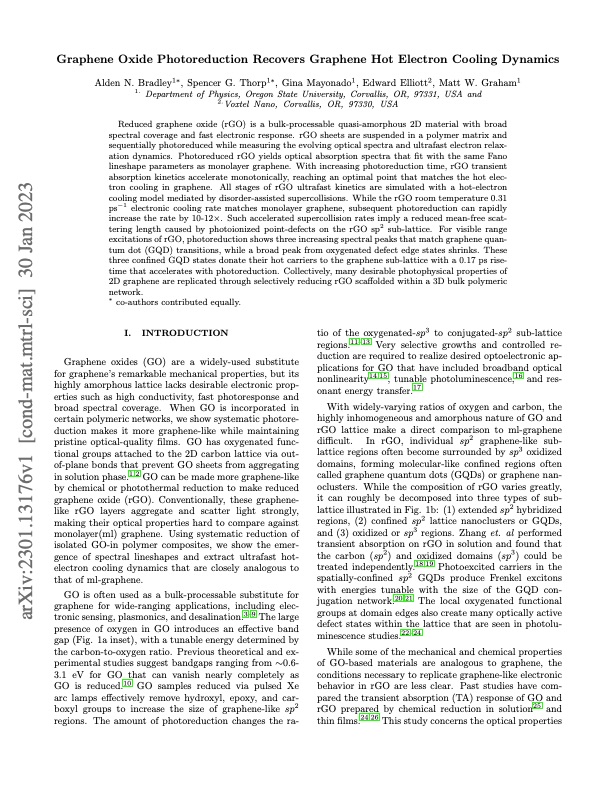
PDF Publication Title:
Text from PDF Page: 001
Graphene Oxide Photoreduction Recovers Graphene Hot Electron Cooling Dynamics Alden N. Bradley1∗, Spencer G. Thorp1∗, Gina Mayonado1, Edward Elliott2, Matt W. Graham1 1. Department of Physics, Oregon State University, Corvallis, OR, 97331, USA and 2.Voxtel Nano, Corvallis, OR, 97330, USA Reduced graphene oxide (rGO) is a bulk-processable quasi-amorphous 2D material with broad spectral coverage and fast electronic response. rGO sheets are suspended in a polymer matrix and sequentially photoreduced while measuring the evolving optical spectra and ultrafast electron relax- ation dynamics. Photoreduced rGO yields optical absorption spectra that fit with the same Fano lineshape parameters as monolayer graphene. With increasing photoreduction time, rGO transient absorption kinetics accelerate monotonically, reaching an optimal point that matches the hot elec- tron cooling in graphene. All stages of rGO ultrafast kinetics are simulated with a hot-electron cooling model mediated by disorder-assisted supercollisions. While the rGO room temperature 0.31 ps−1 electronic cooling rate matches monolayer graphene, subsequent photoreduction can rapidly increase the rate by 10-12×. Such accelerated supercollision rates imply a reduced mean-free scat- tering length caused by photoionized point-defects on the rGO sp2 sub-lattice. For visible range excitations of rGO, photoreduction shows three increasing spectral peaks that match graphene quan- tum dot (GQD) transitions, while a broad peak from oxygenated defect edge states shrinks. These three confined GQD states donate their hot carriers to the graphene sub-lattice with a 0.17 ps rise- time that accelerates with photoreduction. Collectively, many desirable photophysical properties of 2D graphene are replicated through selectively reducing rGO scaffolded within a 3D bulk polymeric network. ∗ co-authors contributed equally. I. INTRODUCTION Graphene oxides (GO) are a widely-used substitute for graphene’s remarkable mechanical properties, but its highly amorphous lattice lacks desirable electronic prop- erties such as high conductivity, fast photoresponse and broad spectral coverage. When GO is incorporated in certain polymeric networks, we show systematic photore- duction makes it more graphene-like while maintaining pristine optical-quality films. GO has oxygenated func- tional groups attached to the 2D carbon lattice via out- of-plane bonds that prevent GO sheets from aggregating in solution phase.1,2 GO can be made more graphene-like by chemical or photothermal reduction to make reduced graphene oxide (rGO). Conventionally, these graphene- like rGO layers aggregate and scatter light strongly, making their optical properties hard to compare against monolayer(ml) graphene. Using systematic reduction of isolated GO-in polymer composites, we show the emer- gence of spectral lineshapes and extract ultrafast hot- electron cooling dynamics that are closely analogous to that of ml-graphene. GO is often used as a bulk-processable substitute for graphene for wide-ranging applications, including elec- tronic sensing, plasmonics, and desalination.3–9 The large presence of oxygen in GO introduces an effective band gap (Fig. 1a inset), with a tunable energy determined by the carbon-to-oxygen ratio. Previous theoretical and ex- perimental studies suggest bandgaps ranging from ∼0.6- 3.1 eV for GO that can vanish nearly completely as GO is reduced.10 GO samples reduced via pulsed Xe arc lamps effectively remove hydroxyl, epoxy, and car- boxyl groups to increase the size of graphene-like sp2 regions. The amount of photoreduction changes the ra- tio of the oxygenated-sp3 to conjugated-sp2 sub-lattice regions.11–13 Very selective growths and controlled re- duction are required to realize desired optoelectronic ap- plications for GO that have included broadband optical nonlinearity14,15, tunable photoluminescence,16 and res- onant energy transfer.17 With widely-varying ratios of oxygen and carbon, the highly inhomogeneous and amorphous nature of GO and rGO lattice make a direct comparison to ml-graphene difficult. In rGO, individual sp2 graphene-like sub- lattice regions often become surrounded by sp3 oxidized domains, forming molecular-like confined regions often called graphene quantum dots (GQDs) or graphene nan- oclusters. While the composition of rGO varies greatly, it can roughly be decomposed into three types of sub- lattice illustrated in Fig. 1b: (1) extended sp2 hybridized regions, (2) confined sp2 lattice nanoclusters or GQDs, and (3) oxidized or sp3 regions. Zhang et. al performed transient absorption on rGO in solution and found that the carbon (sp2) and oxidized domains (sp3) could be treated independently.18,19 Photoexcited carriers in the spatially-confined sp2 GQDs produce Frenkel excitons with energies tunable with the size of the GQD con- jugation network.20,21 The local oxygenated functional groups at domain edges also create many optically active defect states within the lattice that are seen in photolu- minescence studies.22–24 While some of the mechanical and chemical properties of GO-based materials are analogous to graphene, the conditions necessary to replicate graphene-like electronic behavior in rGO are less clear. Past studies have com- pared the transient absorption (TA) response of GO and rGO prepared by chemical reduction in solution25 and thin films.24,26 This study concerns the optical properties arXiv:2301.13176v1 [cond-mat.mtrl-sci] 30 Jan 2023PDF Image | Graphene Oxide Photoreduction Recovers Graphene

PDF Search Title:
Graphene Oxide Photoreduction Recovers GrapheneOriginal File Name Searched:
2301-13176.pdfDIY PDF Search: Google It | Yahoo | Bing
Salgenx Redox Flow Battery Technology: Power up your energy storage game with Salgenx Salt Water Battery. With its advanced technology, the flow battery provides reliable, scalable, and sustainable energy storage for utility-scale projects. Upgrade to a Salgenx flow battery today and take control of your energy future.
| CONTACT TEL: 608-238-6001 Email: greg@infinityturbine.com | RSS | AMP |